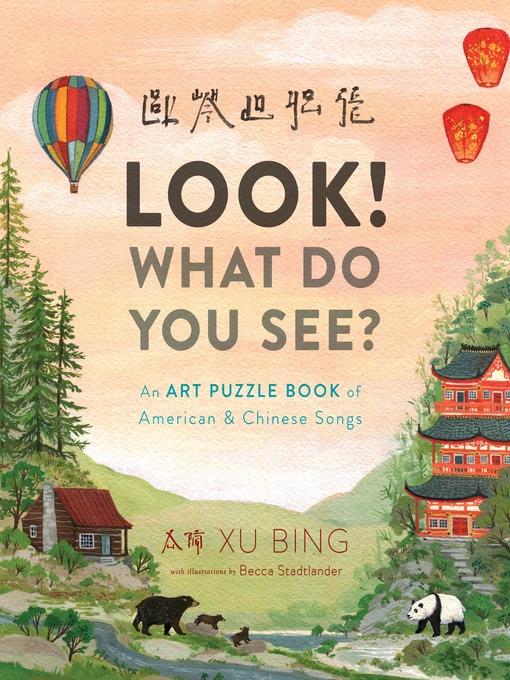
Look! What Do You See?
An Art Puzzle Book of American and Chinese Songs
کتاب های مرتبط
- اطلاعات
- نقد و بررسی
- دیدگاه کاربران
نقد و بررسی

September 1, 2017
Gr 3-6-In 1994, Bing invented Square Word Calligraphy, a "secret code" that looks a lot like Chinese calligraphy. This volume presents the lyrics to 17 songs in that code, accompanied by Stadtlander's beautiful watercolor illustrations. The first dozen are common U.S. folk songs (including "Camptown Ladies," "Yankee Doodle Came to Town," and "Skip to My Lou") and the final five are common Chinese folk songs (including "Tiger Learns to Climb" and "The Snail and the Yellow Birds"). Readers are encouraged to look closely to decipher the text. Starting with the songs they know, students can then crack the ingenious code to read the lyrics to the songs they don't. The back matter contains instructions on writing Square Word Calligraphy as well as all the lyrics to the songs, in case there was a word readers were unable to decipher. While the method of guessing the song based on the picture and then working backward to crack the code is a fun twist, it also makes the book harder to categorize in a library collection, and students may skip over it. The visual look of the code (which is in English, written with stylized letters arranged in a square in a manner that visually borrows heavily from traditional Chinese calligraphy) is significantly different enough from most other English-based codes that cypher fans should be very intrigued and eager to try it for themselves. VERDICT A fun coded puzzle for readers to spend time analyzing, but it may need some handselling for kids to pick up.-Jennifer Rothschild, Arlington County Public Libraries, VA
Copyright 2017 School Library Journal, LLC Used with permission.

September 1, 2017
At first glance, this book looks indecipherable--but look closer!This puzzle book opens with a mission and a clue: it invites readers to investigate pages of what looks like Chinese calligraphy, paired with lushly painted illustrations, to crack a secret code. Would-be codebreakers learn that the first 12 spreads are classic American folk songs ("Maybe you know them from campfire or school bus sing-alongs"), and the remaining five codes are English-language translations of classic Chinese folk songs. This mission may best be enjoyed intergenerationally with a participant who has some American cultural knowledge, as the songs will likely vary in familiarity for younger readers. Having cracked the code, readers of all ages will revel in the thrill of triumph, poring over each rich spread and going on to learn the lyrics of the songs they don't already know, both American and Chinese. Indeed, the experience would be even more satisfying with music to accompany the text, so families may find themselves seeking it out. Stadtlander's vibrantly textured scenes perfectly capture the nostalgia of the songs, and they smoothly transition from the West to the East. A guide to the code and an answer key complete the experience.Wow! This cross-cultural cipher is a feast for the eyes and a challenge for the mind. (Picture book. 8-adult)
COPYRIGHT(2017) Kirkus Reviews, ALL RIGHTS RESERVED.

Starred review from September 25, 2017
At first glance, Stadtlander’s graceful folk art scenes of American life appear to be accompanied by Chinese calligraphy; readers may be tempted to focus on the artwork and pass the Chinese characters by. But contemporary artist Xu’s “top secret assignment” on the first page explains that the first 12 compositions are the words to American folk songs. With this information and the eventual recognition that the “Chinese” glyphs are built out of stylized Roman letters—“I,” “on,” “my,” and “oh” are pretty easy to read—the characters begin to reveal themselves as blocks of Chinese-style brushstrokes that actually depict English words. The first painting shows men and women at a barn dance. Is it “Skip to My Lou”? (It is.) Once readers get the hang of it, guessing the other songs isn’t too difficult, but it’s plenty rewarding. Although the book is not intended as an introduction to reading Chinese, the process of puzzling out Xu’s word glyphs isn’t unrelated to the mental operation of decoding Chinese characters. Five Chinese songs follow for the truly intrepid, and the lyrics and an explanation of Bing’s writing system appears at the end. Ages 7–10. Illustrator’s agency: Bright Group.

November 1, 2017
Grades 2-5 A brief glance at this puzzle book may make it seem all but unsolvable. Fortunately, the introduction provides a clue: the first 12 codes are traditional American songs, such as Camptown Ladies, Home on the Range, and I've Been Working on the Railroad, while the last 5 are traditional Chinese songs. The words are written in Bing's square word calligraphy, which makes some words immediately clear and other words completely baffling. (This is not for the impatient.) Fortunately, Stadtlander's folk art paintings provide picturesque hints to the songs, which should help readers considerably as they puzzle out the answers. A key to how the words can be interpreted is in the back, along with the answers for those who are especially frustrated. The large size of the book in addition to the code itself lends this well to partner or even group work, as kids and adults alike may be stumped. But for those who love a challenge and are especially drawn to Chinese art, the thrill of victory will be worth it.(Reprinted with permission of Booklist, copyright 2017, American Library Association.)

























دیدگاه کاربران